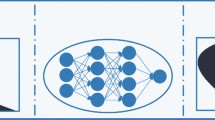Abstract
The continuous advances of Artificial Intelligence (AI) techniques have created new application domains for smaller and more efficient Machine Learning (ML) models. In the context of embedded ML, network sparsification strategies became crucial steps to fit models with severe space constraints. Hence, the aim of this research is to evaluate Neural Network (NN) sparsification and compression on embedded systems. To do so, we investigate the problem of miniaturised binary classifiers (i.e., disease detection) in the computer vision domain. We applied a constant pruning technique during the training process of three architectures: a standard Convolutional Neural Network, CNN in short, (i.e., AlexNet), a residual network (i.e., ResNet), and a densely connected CNN (i.e., DenseNet). We varied: network sparsity (up to 95%), image resolution (from \(8\times 8\) up to \(32\times 32\)), and quantisation. The results indicate that the use of sparse networks has a significant impact on the accuracy of miniaturised binary classifiers. With a 70% of sparsity, it was reached an accuracy improvement of 4% in low-resolution images (i.e., \(8\times 8\)) compared to the standard dense approach. Our findings suggest that sparse NNs can significantly reduce both the size and computational demands of the models while increasing their accuracy on these edge cases.
Access this chapter
Tax calculation will be finalised at checkout
Purchases are for personal use only
Similar content being viewed by others
References
Corazza, A., Isgrò, F., Longobardo, L., Prevete, R.: A machine learning approach for predictive maintenance for mobile phones service providers. In: Xhafa, F., Barolli, L., Amato, F. (eds.) Advances on P2P, Parallel, Grid, Cloud and Internet Computing, pp. 717–726. Springer International Publishing, Cham (2017). https://doi.org/10.1007/978-3-319-49109-7_69
David, R., et al.: Tensorflow lite micro: Embedded machine learning for tinyml systems. In: Smola, A., Dimakis, A., Stoica, I. (eds.) Proceedings of Machine Learning and Systems. vol. 3, pp. 800–811 (2021)
Ding, S., Li, H., Su, C., Yu, J., Jin, F.: Evolutionary artificial neural networks: a review. Artif. Intell. Rev.- AIR 39 (2013). https://doi.org/10.1007/s10462-011-9270-6
Evci, U., Gale, T., Menick, J., Castro, P.S., Elsen, E.: Rigging the lottery: making all tickets winners. In: III, H.D., Singh, A. (eds.) Proceedings of the 37th International Conference on Machine Learning. Proceedings of Machine Learning Research, vol. 119, pp. 2943–2952. PMLR (2020)
Gale, T., Elsen, E., Hooker, S.: The state of sparsity in deep neural networks (2019). https://doi.org/10.48550/arXiv.1902.09574
Kang, S., Park, G., Kim, S., Kim, S., Han, D., Yoo, H.J.: An overview of sparsity exploitation in CNNs for on-device intelligence with software-hardware cross-layer optimizations. IEEE J. Emerg. Sel. Top. Circuits Syst. 11(4), 634–648 (2021). https://doi.org/10.1109/JETCAS.2021.3120417
Liang, T., Glossner, J., Wang, L., Shi, S., Zhang, X.: Pruning and quantization for deep neural network acceleration: a survey. Neurocomputing 461, 370–403 (2021). https://doi.org/10.1016/j.neucom.2021.07.045
Mocanu, D., Mocanu, E., Stone, P., Nguyen, P., Gibescu, M., Liotta, A.: Scalable training of artificial neural networks with adaptive sparse connectivity inspired by network science. Nature Commun. 9 (2018). https://doi.org/10.1038/s41467-018-04316-3
Morik, K., Marwedel, P. (eds.): Volume 1 Machine Learning under Resource Constraints - Fundamentals. De Gruyter, Berlin, Boston (2023). https://doi.org/10.1515/9783110785944
Rajaraman, S., et al.: Pre-trained convolutional neural networks as feature extractors toward improved malaria parasite detection in thin blood smear images. PeerJ 6 (2018). https://doi.org/10.7717/peerj.4568
Acknowledgements
This work was supported by the PRIN 2020 project COMMON-WEARS (grant number I53C21000210001) and by the STEADIER Project (grant number I55F21001900005).
Author information
Authors and Affiliations
Corresponding author
Editor information
Editors and Affiliations
Rights and permissions
Copyright information
© 2025 The Author(s), under exclusive license to Springer Nature Switzerland AG
About this paper
Cite this paper
Cavallaro, L., Serafin, T., Liotta, A. (2025). Miniaturisation of Binary Classifiers Through Sparse Neural Networks. In: Sergeyev, Y.D., Kvasov, D.E., Astorino, A. (eds) Numerical Computations: Theory and Algorithms. NUMTA 2023. Lecture Notes in Computer Science, vol 14476. Springer, Cham. https://doi.org/10.1007/978-3-031-81241-5_22
Download citation
DOI: https://doi.org/10.1007/978-3-031-81241-5_22
Published:
Publisher Name: Springer, Cham
Print ISBN: 978-3-031-81240-8
Online ISBN: 978-3-031-81241-5
eBook Packages: Computer ScienceComputer Science (R0)




